| Home > Policy > White Paper, Notice, Announcement > White Paper > JAPANESE GOVERNMENT POLICIES IN EDUCATION, SCIENCE, SPORTS AND CULTURE 1996 > Priorities and Prospects for a Lifelong Learning Society Chapter 2 Section 2 2 | ||
Apart from schools, the facilities in which learning activities are most likely to take place include libraries, museums (including art museums), citizens' public halls, culture halls, and gymnasiums. Other facilities that are being developed and utilized for learning activities include welfare centers for the elderly and rural environmental improvement centers.
In general, development of such facilities is proceeding steadily. A comparison of the number of social education, sports, and cultural facilities in existence in fiscal 1990 and fiscal 1993 shows that there were especially noticeable increases in the number of museums, which rose from 2,968 to 3,704 (24.8%), and culture halls, which rose from 1,010 to 1,261 (24.9%). While the number of libraries increased from 1,950 to 2,172 (11.4%), the percentage of municipalities with libraries is still low, at 25.5% ( Figure 2.37 ). This situation is also reflected in the results of the 1992 "Public Opinion Survey on Lifelong Learning." When respondents were asked to state the types of facilities they thought should be available for use in lifelong learning activities, the highest percentage (25.7%) chose libraries ( Figure 2.38 ).
A comparison of the results of the MESSC "Social Education Survey" in fiscal 1989 and fiscal 1992 shows that there were increases in the number of people using all types of facilities. There was a particularly marked rise in the number of people using libraries, which expanded from 76.1 million to 100.50 million, an indication that there is extremely strong demand for libraries ( Figure 2.39 ).
When respondents to the 1992 "Public Opinion Survey on Lifelong Learning" were asked to state their wishes concerning public facilities, 39.3% wanted to be able to use them at night and on holidays, 34.7% wanted more courses, activities, and other events in which anyone could participate, and 28.1% wanted the number of facilities to be increased. These results suggest that there is interest in the ways in which facilities are used as well as the development of facilities ( Figure 2.40 ).
According to the fiscal 1993 "Social Education Survey," 88.7% of citizens' public halls were open on Sundays, 54.0% were open until 10:00 or 11:00 P.M., and 35.1% were open almost every day (at least 350 days a year), but 56.4% of libraries still closed before 6:00 P.M. The high level of demand for access to facilities at night and on holidays appears to reflect this situation.
There is also strong demand for schools to be available for community learning activities. As a result, many schools are making their facilities available for community use. Patterns of utilization vary according to the types of facilities available. As of May 1, 1993, 93.5% of public elementary schools, 88.6% of public lower secondary schools, and 63.4% of public upper secondary schools nationwide were making their facilities available to the community. A breakdown shows that 88.1% of elementary schools, 82.6% of lower secondary schools, and 36.6% of upper secondary schools were offering their gymnasiums for public use, while the corresponding figures for school grounds were 84.6%, 76.5%, and 49.1%. The percentages of public schools opening their classrooms or swimming pools to the public were relatively low, however ( Table 2.2 ). In addition, there was considerable variation in the times at which schools made their facilities available and in the number of days these facilities were open to the public.
In recent years there has been an increase in the number of cases in which it is assumed from the start that new school facilities, such as athletic grounds, swimming pools, and classroom blocks, will be used by the community. In addition, more and more schools are converting classrooms that have become surplus, owing to a decline in student numbers and other factors, into community learning facilities, such as libraries or community museums.
Universities and other institutions of higher education are also starting to make their facilities available to the community. For example, some universities are developing special facilities, such as extension centers, for the provision of learning opportunities to people other than formally enrolled students.
Some research and training institutes owned or administered by central government agencies, local governments, and business corporations use their personnel and facilities to offer learning opportunities to the public even though this is not their primary role. For example, research institutes under the jurisdiction of the Science and Technology Agency run Science Camps for young people.
It used to be assumed that learning activities take place indoors, but the diversification of people's activities and growing acceptance of the concept of "learning resources" are reflected in a growing emphasis on other venues, such as riverbanks, seashores, and forests, as places of learning. It has therefore become necessary to develop a broader concept of facilities for learning activities.
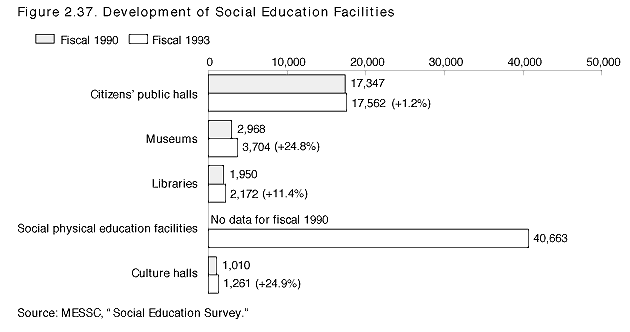
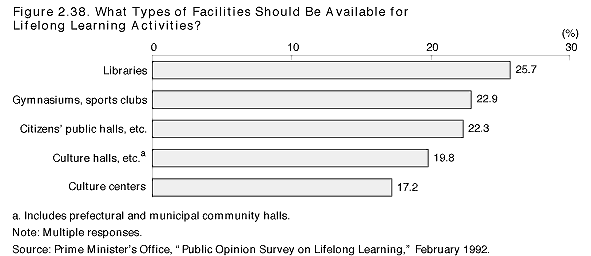
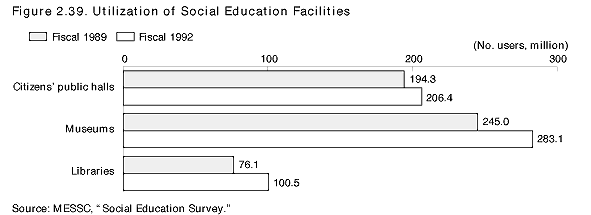
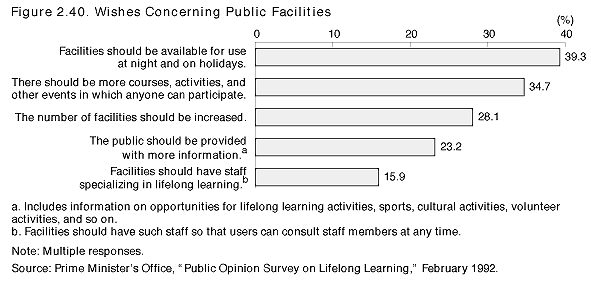
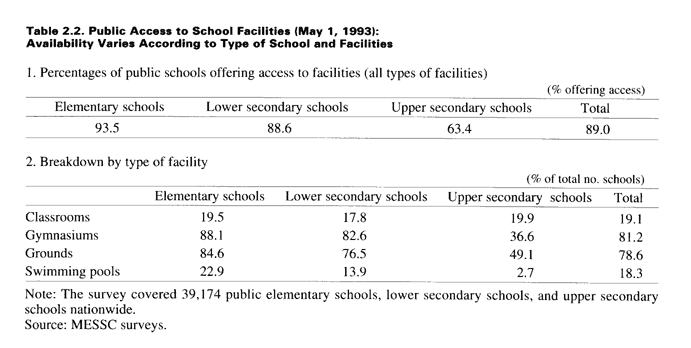
| Back to Top | MEXT HOME |